Expert - View The System "Yoga in Daily Life" as Therapy
Harriet Bucher, Physiotherapist, B. Sc.
Vienna/Austria
(certified YIDL teacher)
Introduction
More than fifteen years have passed since I took my theoretical and practical exam in order to become a Yoga instructor. The system that I trained in is called "Yoga in Daily Life". I was particularly impressed with this system of Yoga because the exercises are set up in a sensible step-by-step program. Consequently, the basic level is possible for everyone to learn and many of the exercises are very suitable for therapy patients.
In the beginning, I simply practised for myself and taught Yoga classes when required. As soon as people realized my profession as a physiotherapist, I was confronted with countless questions about the potential to apply Yoga to specific physiological complaints. Due to this interest, I developed a combined approach of my work as a physiotherapist with my activity as a Yoga teacher. Naturally, I sought further education and exchange of experiences, to achieve a sound knowledge of the application of Yoga in the therapeutic field. In this regard, my Yoga teacher, Paramhans Swami Maheshwarananda, who developed the system “Yoga in Daily Life" in cooperation with doctors and therapists, has been a rich source of knowledge.
In Austria, Yoga has an important place as a therapeutic measure in clinical breath therapy and as a relaxation technique. For instance, many Yoga exercises are described in the "classical" textbook of breath therapy, "Atemtherapie, Ullstein" by Edel, Knaut, Mosby. I have had most inspiring exchanges with therapists and doctors in the Piestany Health Resort in Slovakia. There, the system "Yoga in Daily Life" is applied in orthopedics, rheumatology and pediatrics, as well as internal medicine, in the areas of therapy and rehabilitation.
There are numerous interesting articles and books that report on the effects of Yoga exercises on body and psyche, including many with scientific research and results. It is not my intent to quote these in this paper, however I wish to describe the essential characteristics of Yoga exercises and talk about a few examples of my practical experiences with Yoga in physiotherapy.
Characteristics of a Yoga Session
There are many thousands of Yoga postures, developed by Yogis thousands of years ago with the goal to achieve and maintain physical and mental health. Many of these postures and movements were developed through careful observation and analysis of what occurs in Nature. This is why many Yoga exercises have names such as cat, palm tree, eagle, stork, cobra, tiger and so on.
Yoga exercises can be performed as dynamic movements or as static postures. The more advanced practitioner uses mainly the latter form; for patients, the dynamic techniques are more frequently used.
The Meaning of Relaxation in Yoga
In Yoga, relaxing has as much significance as performing the exercise itself. Each Yoga session starts with a short relaxation that serves to direct the consciousness of the practitioner totally, or at least partially, to the body. Body consciousness is an important prerequisite to being able to consciously perceive muscular tension, uneconomical posture or incorrect load-bearing on the feet. In order to relieve such tension and incorrect load-bearing, they first have to be perceived. The purpose of an introductory relaxation is not only to direct the awareness to the body, but also to regulate the psycho-physiological equilibrium. Conscious relaxation has a balancing effect on all body systems, but particularly on the autonomic nervous system, the respiratory and cardiovascular systems. The more physical and mental balance that is achieved in the short relaxation at the beginning, the deeper will be the effect of the postures. Short relaxation intervals are also used between the exercises, during which the practitioner can become aware of the reactions of the body (muscular tension, circulation, breath rhythm and depth, heartbeat). For many patients these phases of relaxation and the focus on their body are a new learning process that is very precious for the healing process.
The Significance of the Breath in Yoga
There are many breathing techniques in Yoga, which influence all bodily functions, particularly the nervous system. The basic Yoga breathing techniques are very suitable for all patients. These techniques are often used specifically in breath therapy as well. The goal, as in physiotherapy, is to achieve relaxed diaphragmatic breathing, which does not only result in sufficient airing of the lungs, but also has a harmonizing effect on the cardio-vascular, lymphatic, nervous and other body systems. Hyperactivity of the body systems can be calmed and balanced through deep relaxed breathing, and vice versa, stimulation occurs in people with hypoactive body systems.
Yoga exercises are always connected with the breath because the reciprocal influence of breath and movement can be used to intensify the positive effects. As appropriate, the speed of movements is adjusted to the breathing rhythm or the speed of the breath is adjusted to the flow of movements, in order to affect the breath. Specific Yoga positions can influence the depth and direction of the breath - such that areas of the lungs that are not usually well-ventilated can have increased ventilation through utilizing these particular postures.
Characteristics of the Physical Exercises
Almost all Yoga postures are done slowly, very consciously and, as mentioned before, in coordination with the breath. The reason for practising slowly is to stretch tightened and shortened muscles in a gentle manner. By stretching the muscle we trigger a so-called stretch reflex, which means that by stretching the muscle an opposite contraction of the muscle occurs. The faster we stretch the muscle, the more powerful is this opposite contraction (stretch reflex) and the slower the stretching, the weaker the reflex. So by practising yoga asanas slowly we can stretch our muscles to a greater extent than by practising quickly. Practising asanas faster therefore creates much greater possibility of a muscle injury.
Thus the musculature is trained in a dynamic and static way and challenged in regards to balance and coordination. The slow speed allows easier coordination with the breath and makes conscious body control possible. Yoga postures usually include the whole body. This results in exercises that are varied and defined as "holistic".
In a well-planned Yoga session, a balanced practice is achieved by using a combination of bending and stretching, as well as strengthening exercises. It is through this careful application that the desired physical and mental balance takes place.
"Yoga in Daily Life" in Breath Therapy
Yoga can frequently be applied in the field of breath therapy. Different Yoga postures are used with the aim of directing the breath into the parts of the lungs that are usually less ventilated.
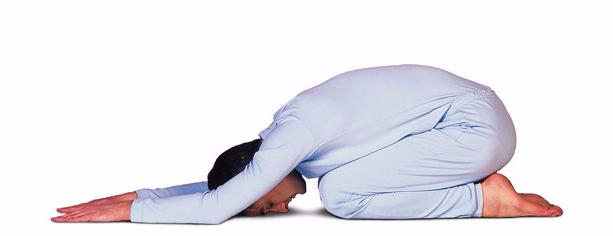
In the posture from Picture 1 (Shashankasana, the hare) the breathing movements in the back and sides of the ribcage are more pronounced.
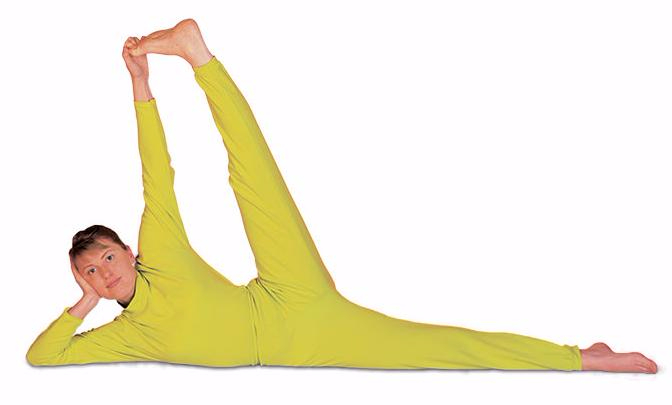
The position in Picture 2 (starting position of Meru Akaranasana) directs the breath mainly into the underside of the stretched torso.
Two additional Yoga techniques that are often applied in physiotherapy also offer great help to patients:
Neti (cleansing of the nostrils and sinuses)
Neti is one of the classical purification techniques in Yoga. A "Neti pot" is used for this procedure. The spout has a conical shape that fits easily into the nostrils. The Neti pot is filled with comfortably warm and slightly salted water. The head is held over the sink and turned to the right. The spout is held into the left nostril and the water is allowed to run into the left nostril and out of the right. After that the water is run through the right nostril and out of the left. To finish the procedure Kapala Bhati is practised: the head and upper body are bent slightly forward; air is deeply inhaled through the mouth and blown out through the nostrils in short, powerful blows (inhale and blow about 25 - 30 times). This practice has a refreshing effect, brings fresh blood flow to the forehead and nose area, purifies the nose and sinuses and strengthens the respiratory system. It is absolutely necessary to have this technique demonstrated by an experienced person (Yoga teacher).
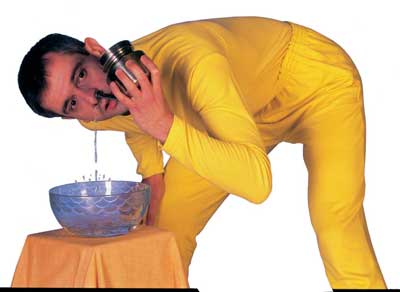
Pranayama – Nadi Shodhana
Prana means breath or life force; ayam means to control, to regulate. Pranayama are Yoga breathing techniques through which Prana is activated and directed to certain areas of the body.
Nadi Shodhana belongs to the basic exercises of Pranayama. Due to the strong balancing effect on the autonomic nervous system, the practice of Nadi Shodhana is not only helpful in breath therapy, but also has a very positive effect on the state of health in many other medical conditions.
Nadi is the Sanskrit word for the nerve pathways and energy channels; Shodhana means to purify. The better and easier our life-force can flow through the nadis, the healthier and more vital we feel.
Yoga teaches us about three main nadis whose proper functioning play a major role in our health: Ida, Pingala, and Sushumna: Ida is activated when breathing through the left nostril – this nadi corresponds to the parasympathetic nervous system; Pingala is activated through the right nostril – this nadi corresponds to the sympathetic nervous system; Sushumna runs centrally along the spine and corresponds with the central nervous system.
Practice of Nadi Shodhana level I: sit comfortably on a chair or on the floor, the spine should be straight. The tips of the index and middle finger of the right hand are placed in the middle of the forehead. The right nostril is closed with the thumb and twenty relaxed and slightly deeper breaths are taken through the left nostril. Then the right nostril is opened and the left nostril is closed using the right ring finger. Twenty inward and outward breaths are taken through the right nostril.
This breathing exercise has a strong calming effect on the nervous system, as well as on the cardiovascular and digestive systems.
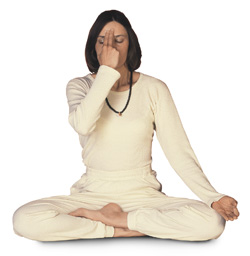
"Yoga in Daily Life" and High Blood Pressure
Since Nadi Shodhana activates the parasympathetic nervous system this breathing technique has a particularly beneficial effect on high blood pressure (hypertension). There are other Yoga breath techniques which also have a strong influence on reducing blood pressure, for example Ujjayi Pranayama, or the so-called "larynx deep breathing technique". The relaxation techniques, breathing exercises and many of the physical exercises of the Yoga system are very suitable for the prevention of high blood pressure or can be used as therapy as well. There are Yoga exercise programs specifically designed for people with high blood pressure, which can be followed after consultation with their doctor.
"Yoga in Dialy Life" as a Cardiovascular Training
There are exercises in this Yoga-system that consist of multiple sequential movements (for example Khatu Pranam) and so comply with the principles of a general aerobic endurance program. They are excellently suited as training for the cardiovascular system. Many Yoga exercises can be performed whilst sitting in a chair, enabling patients with less ability to also practise Yoga. The important role of breath and relaxation give special status to the Yoga exercises in the case of cardiovascular diseases. Nadi Shodhana is a particularly helpful breathing technique for calming, relaxing and deepening the breath, as well as promoting venous backflow from the body tissues to the heart. All inverted postures (such as for example Sarvangasana, the shoulder stand) have a supporting effect on the lymphatic and venous systems. Yoga postures that require a faster breath can be used to stimulate circulation, provided that there are no functional problems with the heart or the existence of high blood pressure.
Utthita Lolasana (swinging of the torso) is given here as an example:
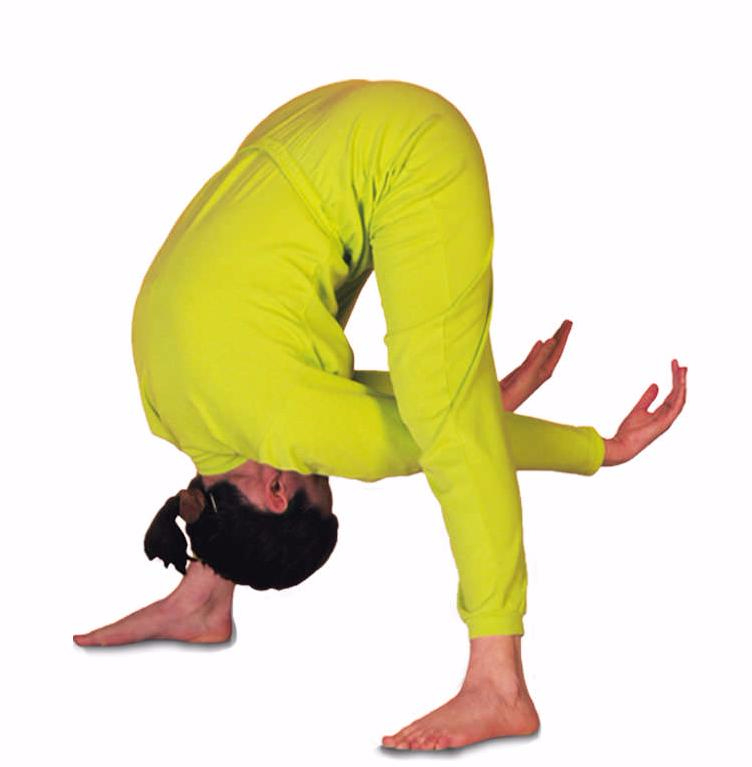
The body is upright and relaxed; the legs are apart. With the inhalation, the arms are lifted over the head, with the exhalation the torso is relaxed hanging downwards. With the next inhalation the torso and arms are lifted horizontally and swung back through the legs with a forceful exhalation. This lifting and swinging through of the torso is done ten times with deep abdominal breathing. The breathing always flows through the nose. After ten repetitions the torso hangs down again, relaxed, and is slowly brought upright with the next inhalation. This is one round and is repeated three times. Of course there are contra-indications for this exercise, such as disc problems, high blood pressure, nausea…but I do not wish to go further into these in this context.
"Yoga in Daily Life" in Neurology
Working in the field of Neurology, I have had great results with patients who have Multiple Sclerosis. Yoga exercises train the sense of balance, concentration and body consciousness. They require an upright posture, train the musculature and have a deepening effect on the breathing.
Ashva Sanchalanasana (Riding posture) is given here as an example (picture 6): Starting position is standing with legs apart. Then the left foot, as well as the torso and head, are turned to the left. Bending the left knee the weight is transferred onto the left foot. As the right leg is without weight the right heel is turned to the right and the knee is bent slowly, until it touches the ground. The torso stays upright and the arms are stretched down. The pelvis is moved gently towards the floor to stretch the hip joints. This exercise strengthens the leg muscles. It requires correct weight bearing onto the front leg, good knee stabilization, balance, concentration, good body awareness and good posture. The exercise is then done on the other side.
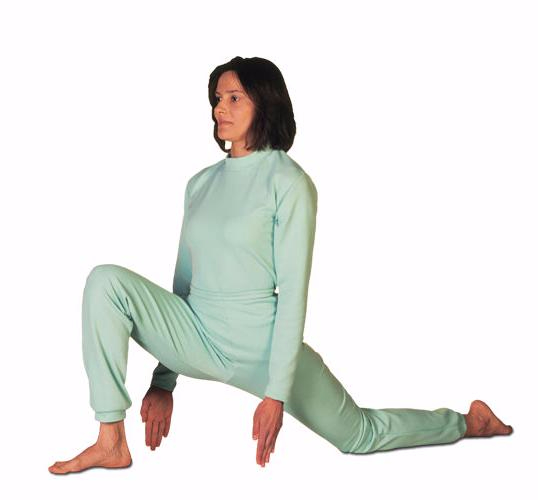
Sufficient pauses for relaxation and a slow pace of movements to prevent overtaxing are very important with patients who have Multiple Sclerosis.
There is also a great choice of suitable Yoga exercises for patients who are hemiplegic, which I won't list and describe in this context.
"Yoga in Daily Life" in Orthopedics
"Yoga in Daily Life" can be used beneficially in many ways in this area. Many of the stress-relieving dynamic movements, coordinated with the breath are very suitable for patients with osteoporosis. They are also very helpful for patients with arthritic conditions. The dynamic movements practised slowly, promote blood flow to the muscles as well as production of synovial fluid in the joints. They stretch and strengthen the musculature consequently aiding the movement and stability of the joints.
I most frequently use "Yoga in Daily Life" to help with body posture. For this reason I have developed an eight-step exercise program under the instructions of my Yoga teacher and in cooperation with doctors and other physiotherapists, and have practised this with countless patients. A book has been written as a result of this work: "Yoga Against Back Pain" (P.S. Maheshwarananda, published 1998, Maudrich-Verlag). This book is primarily meant to be used for prevention and of course cannot replace a doctor or therapist in the case of existing problems.
I very much like to employ "Yoga in Daily Life" in the area of postural training, since the exercises have such a holistic effect. As mentioned previously, most Yoga postures involve the whole body in the movement or the specific position. There are exercises that work on the correct load-bearing of the feet, on good knee stability, as well as correct pelvic position or the straightening of the spine.
Eka Pad Pranamasana is taken as an example (One-legged position):
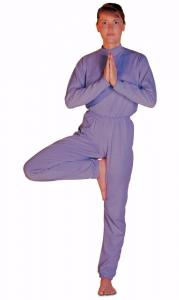
Yoga exercises can also have a positive influence on body posture through their strengthening, stretching and stabilizing effects.
Psychology and posture are closely interwoven, as is widely known. Since well-performed Yoga postures improve self-confidence and "endurance" and have a calming effect, they influence not only the body but also the psyche, in a positive way.
Conclusion
Naturally, this short description about the use of "Yoga in Daily Life" in therapy cannot claim to be complete. Yoga is also helpful with other complaints which occur all too often in our modern society – such as "burn-out" syndrome, sleep disorders, migraines, depression, as well as concentration difficulties which form the root cause of many diseases of our times.
In practising Yoga, we define disease as a disturbance of the equilibrium within the body. Restoration of the physical and psychological equilibrium and promotion of the body’s self-regulation, are the goals of each Yoga session. Therefore the system "Yoga in Daily Life" , for me, is a valuable path to health and offers itself as a helpful technique in therapy, but also as rehabilitation and as a preventative measure.
Pictures in this article are taken from the book YOGA IN DAILY LIFE THE SYSTEM by Mahamandaleshwar Paramhans Swami Maheswarananda.